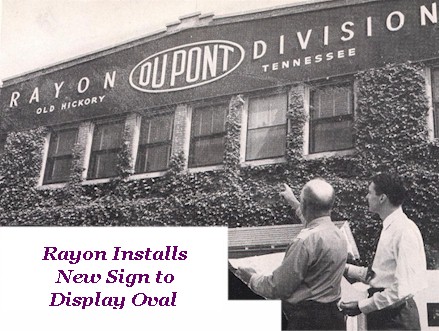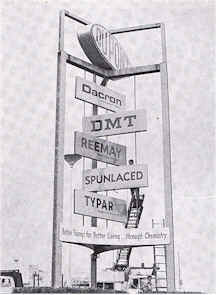|
|||||||||||||||||
|
|
|||||||||||||||||
| The Du Pont Oval as we
know it today appears millions of times each year in advertising, on Du
Pont products and is worn by thousands of employees in the form of
service pins.
Du Pont's top salesman receives neither a salary nor a commission, never reports a sale and never turns in an expense account. He has no office of his own, but makes himself home in yours or mine. And while he never rings a doorbell, he gets in more homes, sees more customers and makes more sales than any regular Du Pont salesman ever could. - Rayon Yarns, April 4, 1956 Keep reading to learn more about the oval!
|
|
||||||||||||||||
| Note: The original DuPont gunpowder ad pictured above and the one that appears in the DuPont- Old Hickory 2002 calendar is quoted on an internet site to now be worth $21,000. Memorabilia from the earlier years bearing the DuPont oval and name are readily available on the internet and on auctions sites such as Ebay. | |||||||||||||||||
| Origins of Du Pont Oval | |||||||||||||||||
| Rayon Yarns, June 1948 | |||||||||||||||||
|
|||||||||||||||||
| When the new sign bearing the Du Pont
Oval was recently installed over the front entrance to the plant, many
necks were craned and many admiring remarks were heard, as well as a few
skeptical comments such as "wonder how long that gold paint will
stay shiny? " A few questions put to our Works Engineering Section,
who had charge of the plans for the new sign, elicited the information
that the raised letters and Oval were salvaged from the old sign,
covered with 22-carat gold leaf (which is not supposed to tarnish) and
put on a new background of black Smaltz glass. The words "Old
Hickory, Tennessee" are new and are also of gold leaf.
We can well be proud of the handsome new sign and even prouder of what the Oval stand for. Among the best known of all trade-marks, it marks all our product s and instantly proclaims to the purchasers, "This product was made by Du Pont." It has come to be known as a mark of quality and a symbol of good faith on the part of the manufacturer. Every year the Oval appears more than FIVE HUNDRED MILLION TIMES in paid advertising space alone. It is blazoned on cases, drums, barrels, tank cars, motor trucks, and cans. It is printed on folders, brochures, broadsides, leaflets, letterheads, envelopes and checks. It is seen at fairs, in moving pictures and radio studios and reproduced in every medium from printer’s ink to neon. There are Du Pont Ovals as big as a good-sized swimming pool painted on buildings and tanks at the Company’s plants where they may be seen from passing trains and planes; and in the form of service pins they grace the lapels, neckties and dresses of thousands of Du Pont employees. In 1906, the Company commissioned one G.A. Wolf, an artist, to design a trade-mark which would identify its growing list of products in the public mind. Wolf seems to have considered only an oval form, probably because the word "Du Pont" fitted into it harmoniously. His design may have been further influenced by the fact that most of the Company’s products of that day were shipped in barrels, kegs and drums and the Oval could be neatly placed on the ends of these containers. Wolf’s Oval, first used in 1907, is not the one in use today. The original Oval carried a serpentine ribbon entwined in the letters, bearing the words "Established 1802." It may still be seen in the original form on the cover of the annual stockholders’ report. Elsewhere it has virtually disappeared. The reason is a practical one. It was impossible to retain the ribbon and cut satisfactory stencils for marking wood kegs and shipping cases. The ribbon had to go and its going left the Oval that is familiar to us today. For the first 105 years of its existence, the Du Pont company did very well without a trade-mark. But in the past 41 years, the well-known Oval has become its most distinctive and one of its most valuable assets. To all the world it symbolizes "Better Things for Better Living…..Through Chemistry." The biggest Oval in use on the plant is the one on the new sign, twelve feet long. The smallest forms a background pattern on your plant pass, and perhaps the next smallest is that found at each corner of your paycheck.
|
|||||||||||||||||
| Signs of the Time | |||||||||||||||||
| Signs have always played an
important role in our lives as DuPont employees. Below, you will
find photos of some of the signs from the past as well as the present.
Signs have been used on site for various reasons from safety (the most
popular) to mourning the loss of soldiers. If you look
around today, you will notice that signs are everywhere. In the
Powder Plant days, it has been noted that signs played an important role
in keeping men and women motivated. While in the WWII era, signs
were used to remind employees to buy war bonds.
|
|||||||||||||||||
|
|||||||||||||||||











